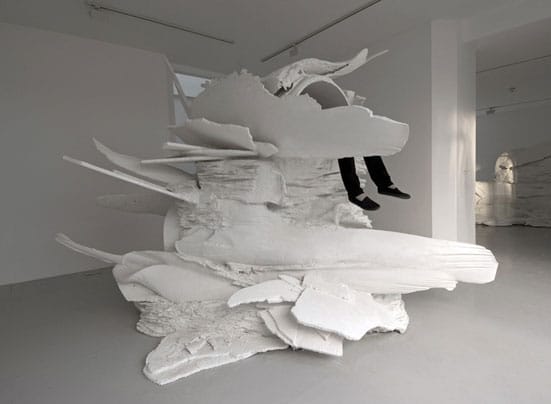10th October 2007 — 17th November 2007
Down
in the basement of the Lisson Gallery lurks an inscrutable Bactrian
camel with a tractor tyre tight around its middle, wedged between its
two sagging humps. Internal Combustion (Eye of the Needle) is a short
video where the tyre-ed camel is standing in the forecourt of a petrol
station in Tehran; cars, lorries and tankers top up at the pumps in the
background. The camel paces absentmindedly, watching sideways the
stream of vehicles filling their tanks. The scene casts the camel as
seemingly native, at once unassuming, apathetic to the hubris of
humanity, slowly batting its great eyelashes at the absurdity of our
plight. This is a familiar role in Allora and Calzadilla's previous
works, but also in a wider context. Animality is not only a powerful
antagonist to latent humanism, but it's also used as a means of
objectifying human perspective - to be observed by the mute sentience
of nature. Invariably, animals appear meditative, as pacific aliens who
we abuse (witness the tractor tyre) with impunity. The contrast of the
camel with the thrumming cars and petrol station behind, is emblematic
of specific, regional antipathy and familiar, prevalent separations.
Judeo-Christian pre-eminence in the West is abutted with the Islamic
governance in Iran; but neither is 'represented' clearly. An
interpretative hegemony is certainly not forthcoming. The
Judeo-Christian specificity of the 'eye of a needle' aphorism might
hint at a defining antagonism, but the shift from allegory to literal;
of aphorism to nonsense, shrugs off our unambiguous reading. An
interruption of the flow of information, rendering hegemonic structures
as fluid and opaque, is at the heart of this exhibition.
Upstairs there are two large sculptures entitled Sediments
Sentiments (Figures of Speech). At the opening of the exhibition, these
teetering formations were the unconventional platforms for a series of
sung performances. These makeshift rostra look like the petrified,
ashen ruins of a modern day Pompeii: jutting, industrial angles are
stratified with flakes of stone and root-veined earth, the whole form
bleached a uniform white. Bisecting the layers are sections of tubing,
sewer-sized and fragmented; here the performers lay, entombed within
the rubble. The lyrical recitation of their operatic songs comprised
quotes from speeches given by political figureheads including Saddam
Hussein, the Dalai Lama, George W Bush and Martin Luther King. The
words become unfocused, appropriated under a new duress: the pomp of
opera replacing that of political oration, supplanting historical and
political accuracy with indiscriminate commemoration. The past potency
of these words is lost or transfigured into unfamiliarity, and the
words are returned to their democratic origins.
Similarly, the newspaper collages on the walls of the gallery enact a
process of confounding the authority of words, where gingerly edited
photos of current events in every field are treated as constituent
letters: a pair of outstretched arms becomes the crossbar of a 'T'; a
spread pair of legs the arch of an 'A'. The sentences depicted are
expounded in the titles, and again quote infamous statements issued by
political spokespeople. 'Ladies and gentlemen, we got him!' was spoken
by L. Paul Bremer on the event of Saddam Hussein's capture, but here is
subsumed by the media via pictographic representations of letters. The
words and their intended meaning gather sediment on their journey into
the public sphere, and become encased within a global web of
information and disinformation - the importance of their origin
displaced. This is certainly a democratising process, where authority
is dethroned in the very act of transmission, but it is also
dangerously trivialising. Allora and Calzadilla are all too aware that
the act of translation is anything but transparent; that interpretation
and intention are non-linear in relation to one another, and that the
means of communication is just as pivotal as what is said. By signing
over the role of explicitness to their accompanying texts and titles
(there is a hefty press release to accompany this exhibition), the
works themselves are advantageously positioned. They deliberately
become embroiled in a mire of meaning and deflated rhetoric, embracing
the fractured destinies of their ideas by pre-empting them.
EA
Lisson Gallery
29 & 52-54 Bell Street
London NW1 5DA
http://www.lissongallery.com/
Open
Monday-Friday, 10am-6pm
Saturday 11am-5pm
